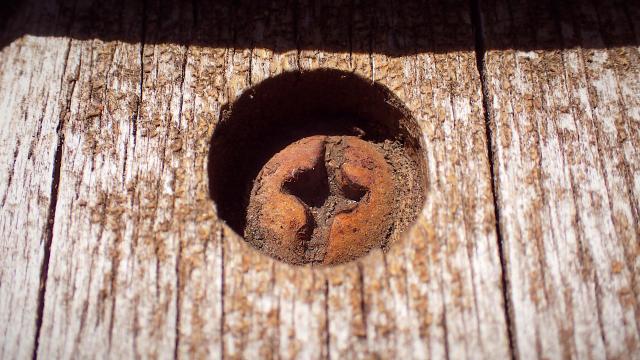Not only are rusted screws hard to unscrew, but they often also have damaged heads that can break off altogether, causing even more complicated problems. Here are five things you can try to remove a rusty, stripped screw without ruining the surface you’re working on.
How to remove a rusty screw
First, patience over muscle
Taking out a rusted screw requires some patience. In the shop, we call this kind of thing precision persuasion, because even though you might need to use a hammer and some other heavy artillery, you need to exert force in a careful way to get the screw out without causing damage to the object it’s stuck in. You don’t need to be an expert to turn a stuck, rusted, or stripped screw, but you do need to be patient.
For this project, you’ll need some of the following, depending on what method you use:
- A hammer
- A screwdriver
- Rust penetrant
- Channel lock pliers or vice grips
- An extractor set
- An adjustable wrench
- A drill
- Heavy-duty gloves
- A heat gun
- A hack saw or rotary tool with a metal grinding bit
Use lubricant and percussive maintenance
If you have a rusted screw that won’t turn easily, before getting out your impact driver and using brute force, try using some lubricant and a little bit of what I like to call “percussive maintenance.” Tap the head of the screw with your hammer a couple of times to loosen up the rust a little bit. Then, apply your all-purpose lubricant to the area and give it a few more taps to create some space for the penetrant to work. Leave it to do its work for 15-30 minutes, then try using a screwdriver or your drill with a screwdriver bit in it. If the head of the screw is stripped or too damaged to accommodate the bit, you’ll have to add some other tricks to your arsenal.
Use pliers for better leverage
If the screw is protruding from the surface, you can use a combination of rust penetrant and channel lock pliers or vice grips. While vice grips definitely offer a better advantage because they lock into position, channel lock pliers offer enough leverage to be a possible solution if you don’t own vice grips. Use your tool to slowly turn the screw counterclockwise. If it’s still seized up, you can add the lubricant and hammer method.
Use an extractor kit
If the screw is broken or the head of the screw is too damaged for a driver, an extractor kit is likely your best option. This kit involves a drill bit to smooth out the head of the screw, and a spiral bit that can grab onto the head of the screw by turning against the direction of the threads first and digging into the surface before turning counterclockwise to remove the stripped screw. Make sure to wear gloves for this part, because there could be barbs from the screw or metal shavings caused by drilling into the head of the screw.
Put some heat on it
If you’re working on a screw in metal, or if there are seized washers involved, you can also try using some heat to get the screw turning. Metal expands when it’s heated, so heat can help break the rust off the outside of the screw and allow it to turn. You can sometimes even try this with a hair dryer. You should also give the head of the screw a few good whacks with your hammer after applying heat to help break the bond between the rust and the metal.
Make a new slot
If the head of your rusted screw is stripped, you can sometimes get it turning by cutting a slot in the head of the screw. Using your hacksaw or rotary tool, cut a slot in the head of the screw big enough to accommodate a flathead screwdriver. To get the screw turning, you can use a wrench on the handle of the driver, or you can use a drill with a flathead bit.

Leave a Reply
You must be logged in to post a comment.